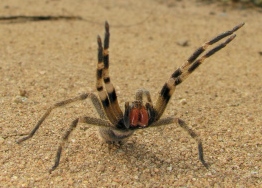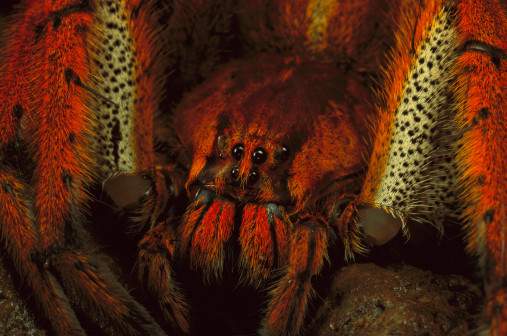Development & Reproduction
Reproduction
Like all members of the animal kingdom, the Brazilian
Wandering Spider is dioecious meaning that it has separate sexes
(male and female). Spiders always undergo sexual reproduction
and this does not change within this species. In almost all
species of spiders, including P. fera, the female is
larger than the male. This means that the male will have to
approach the female with caution when attempting to mate because
of the possible risk that the female will attempt to eat the
male. The male’s way of showing this is by performing some sort
of “dance” or ritual. In the case of the P. fera mating
is very competitive and males will often fight with one another
over the females and females will often turn down many males
before she decides on a male that she wishes to mate with. The
courting ritual for the male P. fera is to vibrate his
pedipalps (which are
 sensory organs next to the mouth). To show
that the female is willing to mate she will remain passive, in
some cases vibrate her pedipalps, and not chase the male away.
However after the actual mating process has occurred, the male
will then run away or be consumed by the female. Now that the
female has the sperm she can either fertilize the eggs right
away or keep the sperm separate for up to a year until she is
ready.
sensory organs next to the mouth). To show
that the female is willing to mate she will remain passive, in
some cases vibrate her pedipalps, and not chase the male away.
However after the actual mating process has occurred, the male
will then run away or be consumed by the female. Now that the
female has the sperm she can either fertilize the eggs right
away or keep the sperm separate for up to a year until she is
ready.
Generally a few weeks after copulation occurs, the female
will lay her eggs. The eggs are not fertilized until right
before they are laid. As the eggs leave the female body they
will be covered in a clear gelatinous liquid which will
eventually dry and hold the eggs together in a large mass. After
she has laid all of her eggs, sometimes upwards of a 1000, the
female will then encase the eggs in silk.
Development:
After the eggs hatch, the development of the
P. fera can be divided into 2 main stages: larval and nympho-imaginal. The larval stage consists of both the prelarva
and larva. The prelarva is characterized by a lack of mobility,
incomplete leg segmentation, lack of hair and spines, no claws,
barely differentiable spinnerets, and lack of sexual organs. The prelarva stage consists of the period of time immediately after
the spider leaves the egg until the spider has gone through
either one or two molts. After molting a couple of times the
spider will resemble the larva stage. The larva stage is
characterized by very little mobility, complete segmentation,
the development of (undifferentiable) hairs and spines, simple
claws, a cheliceral claw that lacks a poison canal, spinnerets
without spigots, as well as undeveloped sexual organs. The larva
will go through another one to two molts and then enter into the
first stage of the nympho-imaginal stage which is called the
nymph stage. This stage is characterized by complete mobility, a
large variety of hairs and spines, differentiated claws as well
as a fully developed cheliceral claw and functional spinnerets.
The spider will then go through between 5-10 more molts in which
the only changes will be increase of size. After the last molt
the spider will gain functional sexual organs and be considered
a self-sufficient adult.
characterized by a lack of mobility,
incomplete leg segmentation, lack of hair and spines, no claws,
barely differentiable spinnerets, and lack of sexual organs. The prelarva stage consists of the period of time immediately after
the spider leaves the egg until the spider has gone through
either one or two molts. After molting a couple of times the
spider will resemble the larva stage. The larva stage is
characterized by very little mobility, complete segmentation,
the development of (undifferentiable) hairs and spines, simple
claws, a cheliceral claw that lacks a poison canal, spinnerets
without spigots, as well as undeveloped sexual organs. The larva
will go through another one to two molts and then enter into the
first stage of the nympho-imaginal stage which is called the
nymph stage. This stage is characterized by complete mobility, a
large variety of hairs and spines, differentiated claws as well
as a fully developed cheliceral claw and functional spinnerets.
The spider will then go through between 5-10 more molts in which
the only changes will be increase of size. After the last molt
the spider will gain functional sexual organs and be considered
a self-sufficient adult.
Click here to
proceed to the Classification/Phylogeny page



